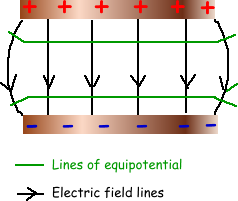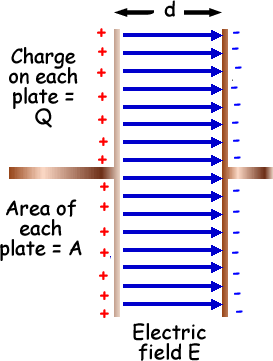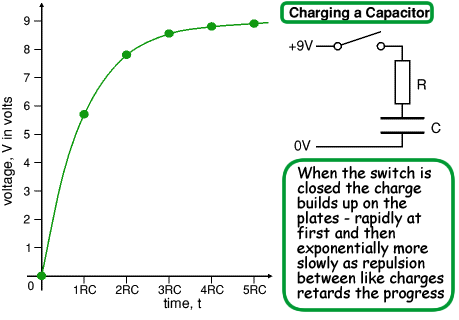Capacitors
A capacitor or condenser is an electrical or electronic device that can store energy.
It stores the energy within the electric field between a pair of conductors (called "plates"). The process of storing energy in the capacitor is known as "charging", and involves electric charges of equal size, but opposite charge, building up on each plate.
Once charged the plates have a uniformelectric field between them. Within the main body of the plates this field is truly uniform - but at the edges the uniformity is disrupted due to 'edge effects'. Therefore any practical work should take account of this.
Capacitors are often used in electric and electronic circuits as energy-storage devices. There are many different types but in physics questions you are usually asked about a simple parallel plate capacitor. In electronics you will learn about the many types and their uses.

If we connect up circuit A and then close the switch we would observe the bulb lighting up brightly and then getting gradually dimmer until it went out. (This would happen quickly so we would just observe a flash).
This is because the brightness of the bulb will depend upon the size of the current flowing. Initially charge would flow quickly onto the plates of the capacitor (brightly lit bulb) then, as the plates began to fill with charge, the rate of charge flow would exponetially decrease (bulb would grow dimmer) until finally the capacitor would be fully charged and no more charge woul flow (bulb would be dark).
With circuit B, however we would not even notice that the capacitor was there! the bulb would remain lit all of the time. The capacitor would never be fully charged it would be in the process of charging 50 times a second on opposite plates - therefore there would be a good rate of charge transfer (current) to keep the bulb brightly lit up.
The capacitor therefore blocks d.c. current but allows a.c. current through.
Capacitance
The capacitor's capacitance (C) is a measure of the quantity of charge (Q) stored on each plate when a given potential difference or voltage (V) is applied across the plates:

So capacitance is defined as:
The ratio of charge stored on an isolated conductor to the difference in potential.
The charge required to cause unit potential difference in a conductor
Units
In SI units, a capacitor has a capacitance of one farad (F) when one coulomb (C) of charge is stored when one volt (V) of potential difference is applied across the plates. Since the farad is a very large unit, values of capacitors are usually expressed in microfarads ( F), nanofarads (nF), or picofarads (pF).
F), nanofarads (nF), or picofarads (pF).
 Parallel Plate Capacitor
Parallel Plate Capacitor
For parallel plate capacitors the capacitance (C) is proportional to the area of each of the conducting plates and inversely proportional to the distance between the plates - as long as the area (A)is much, much greater than the distance between the plates (d) squared.
It is also proportional to the permittivity of the dielectric ( ). The dielectric is the insulator substance that separates the plates - often that is air.
). The dielectric is the insulator substance that separates the plates - often that is air.
The capacitance of a parallel-plate capacitor is therefore given by:
When there is a difference in electric charge between the plates, an electric field is created in the region between the plates. The electric field that created is proportional to the amount of charge that has been moved from one plate to the other. This electric field creates a potential difference V between the plates of this simple parallel-plate capacitor.
V = Ed


No comments:
Post a Comment